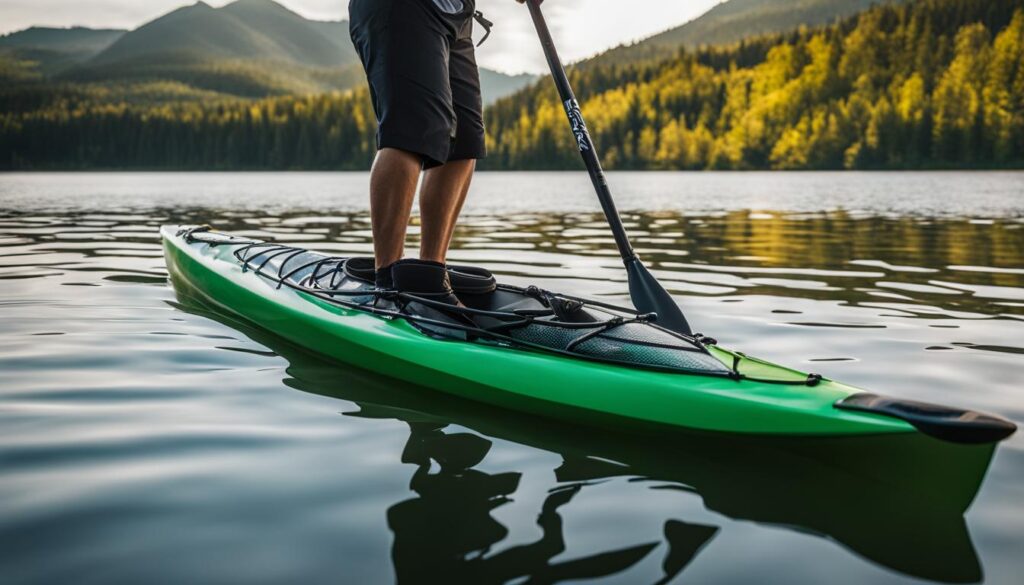Welcome to our guide on choosing the right paddle for your recreational kayaking adventures. A well-selected paddle can greatly enhance your experience on the water, ensuring comfort, efficiency, and enjoyment. In this article, we will explore the various factors that you need to consider when choosing a kayak paddle, including length, weight, materials, blade shapes, and overall efficiency. By understanding these factors, you will be able to make an informed decision and find the perfect paddle that suits your needs and paddling style.
Key Takeaways:
- Choosing the right kayak paddle is crucial for a successful and enjoyable kayaking experience.
- Factors to consider include paddle length, weight, materials, blade shapes, and efficiency.
- Personalized paddle length can enhance comfort and paddling efficiency.
- Lightweight materials, such as carbon fiber and fiberglass, offer durability and reduce fatigue.
- Different paddle blade shapes are suited to different paddling styles and grip comfort.
Selecting the Right Kayak Paddle Length
When it comes to choosing a kayak paddle, one important factor to consider is the length of the paddle. The length of your paddle will greatly impact your paddling efficiency and overall comfort on the water. Finding the right paddle length can help you paddle with ease and prevent unnecessary strain or fatigue.
So, how do you determine the appropriate paddle length for your kayaking needs? There are a few key factors to consider. Firstly, your boat width plays a significant role in determining paddle length. Generally, wider boats require longer paddles to reach the water comfortably. Secondly, your height also factors into the equation. Taller individuals may require longer paddles, especially if they are paddling narrower boats.
It’s important to find the right balance between paddle length and comfort. A paddle that is too short may cause you to lean forward excessively, straining your back and shoulders. On the other hand, a paddle that is too long may feel cumbersome and inefficient. Many paddle manufacturers provide paddle length recommendations based on these factors, so be sure to consult their guidelines or speak with a knowledgeable salesperson.
“Choosing the right paddle length is crucial for a comfortable and efficient kayaking experience. A paddle that is too long or too short can negatively affect your paddling technique and overall enjoyment on the water. Take the time to find the right paddle length for you, and you’ll be rewarded with smoother strokes and less fatigue.”
| Boat Width | Recommended Paddle Length |
|---|---|
| Narrow (less than 23 inches) | 200-210 cm |
| Medium (23-26 inches) | 210-220 cm |
| Wide (26+ inches) | 220-230 cm |
Remember, these measurements are general guidelines, and personal preferences may vary. Some paddlers may prefer slightly shorter or longer paddles for their specific needs and paddling style. Ultimately, the goal is to find a paddle length that allows for efficient strokes and a comfortable paddling position.

Personalized Kayak Paddles
If you’re looking for an even more customized paddling experience, you may consider personalized kayak paddles. Some paddle manufacturers offer options for adjusting paddle length to suit individual preferences. These paddles typically have telescoping or adjustable shafts, allowing you to fine-tune the length to your exact specifications.
Personalized kayak paddles can be particularly beneficial if you have unique requirements due to your body proportions, paddling technique, or the type of kayaking you enjoy. By having a paddle that is tailored to your needs, you can optimize your performance and comfort on the water.
When selecting a personalized paddle, be sure to consider the other factors discussed in this article, such as paddle material, blade shape, and grip comfort. Finding the right combination of features will help you create a paddle that is truly personalized to your unique preferences.
Exploring Different Paddle Material Choices
When it comes to choosing a kayak paddle, the material used in its construction plays a crucial role in its performance and durability. There are various paddle material choices available, each with its own advantages and considerations.
A popular option for ergonomic kayak paddles is carbon fiber. Carbon fiber paddles are known for their lightweight nature, making them easier to maneuver and reducing fatigue during long paddling sessions. These paddles also offer excellent durability, ensuring they can withstand the demands of rough waters and frequent use.
Another common material choice is fiberglass. Fiberglass paddles also provide a good balance of strength and weight, making them suitable for kayakers of all skill levels. They offer a more affordable option compared to carbon fiber paddles while still maintaining durability and performance.
“I switched to a carbon fiber paddle and immediately noticed a significant difference in my kayaking experience. The lightweight design makes paddling effortless, and the durability gives me peace of mind when exploring challenging waters.” – James, experienced kayaker
For those looking for a budget-friendly option, aluminum paddles are widely available. While they may be heavier compared to carbon fiber and fiberglass, aluminum paddles offer good durability and strength, making them a reliable choice for recreational kayakers.
| Material | Advantages | Considerations |
|---|---|---|
| Carbon Fiber | Lightweight, durable | Higher cost |
| Fiberglass | Affordable, durable | Less lightweight compared to carbon fiber |
| Aluminum | Budget-friendly, durable | Heavier compared to carbon fiber and fiberglass |
Ultimately, the choice of paddle material depends on your preferences, budget, and intended use. Consider the weight, durability, and performance aspects to find the paddle material that best suits your kayaking needs.

Summary:
- Choosing the right kayak paddle material is crucial for performance and durability.
- Carbon fiber paddles offer lightweight design and excellent durability.
- Fiberglass paddles provide a balance of strength and weight at a more affordable price point.
- Aluminum paddles are budget-friendly and durable, although they are heavier.
Understanding Kayak Paddle Blade Shapes
When it comes to choosing the right kayak paddle, it’s important to consider not only the length and material but also the shape of the paddle blades. The blade shape can greatly impact the performance and efficiency of your paddling experience. Different blade shapes are suited to different paddling styles and conditions, so understanding the options available can help you make an informed decision.
High-Angle Blades
High-angle blades are designed for more aggressive and vertical strokes. They provide more power and are ideal for those who prefer a fast-paced paddling style or frequently paddle in rough water conditions. The increased surface area of high-angle blades allows for more propulsion and a faster pace, but it can also require more energy and be less efficient for relaxed paddling.
Low-Angle Blades
On the other hand, low-angle blades are designed for a more relaxed and extended paddling style. They offer increased efficiency and are suitable for longer trips or paddlers who prefer a slower pace. Low-angle blades have a narrower and longer shape, which reduces resistance and allows for smoother strokes. They are often more forgiving on the joints and muscles, making them a popular choice for recreational kayakers.
No matter which blade shape you choose, grip comfort is also an important consideration. Look for paddles with ergonomic grips that provide a comfortable and secure hold. This will help reduce fatigue and enhance your overall paddling experience.
| Blade Shape | Advantages | Disadvantages |
|---|---|---|
| High-Angle Blades | More power and propulsion | Requires more energy, less efficient for relaxed paddling |
| Low-Angle Blades | Increased efficiency, suitable for longer trips | Slower pace, less power |
Choosing the right blade shape ultimately depends on your paddling style, preferences, and the type of kayaking you plan to do. Before making a decision, consider factors such as speed, efficiency, comfort, and the conditions you’ll be paddling in. By understanding the different blade shapes and their advantages, you can select a kayak paddle that truly enhances your paddling experience.
Conclusion
Choosing the right kayak paddle is crucial for maximizing your performance and enjoyment on the water. By considering factors such as paddle length, material choices, blade shapes, and grip comfort, you can select a paddle that suits your individual needs and paddling style.
When it comes to selecting the perfect paddle, there are various options available. If you prefer a lightweight paddle for easy maneuverability, consider opting for ergonomic and durable materials like carbon fiber or fiberglass. These will not only enhance your paddling efficiency but also reduce fatigue during long trips.
Blade shapes play a significant role in paddle performance. High-angle blades are ideal for aggressive and vertical strokes, while low-angle blades offer greater efficiency for relaxed and extended paddling. Additionally, choosing a paddle with a comfortable grip is essential to prevent strain on your wrists and shoulders.
Don’t be afraid to explore different paddle choices and test them out before making a final decision. Whether you need an adjustable, personalized paddle or one that is specifically designed for your paddling style, finding the right paddle will enhance your kayaking adventures and ensure a memorable experience on the water.
FAQ
How do I choose the right length for my kayak paddle?
The length of your kayak paddle depends on factors such as your boat width and your height. Wider boats and taller individuals generally require longer paddles. Finding the right balance between length and comfort is important for efficient paddling. Some paddles can be personalized to fit individual preferences and needs.
How does the choice of materials impact the performance of a kayak paddle?
The materials used in the construction of a kayak paddle can greatly affect its performance and durability. Lightweight materials like carbon fiber or fiberglass enhance paddling efficiency and reduce fatigue. These materials are also known for their durability, ensuring that your paddle will last for many seasons of kayaking adventures. Ergonomic designs can further enhance comfort and reduce strain on your wrists and shoulders.
What is the significance of the paddle blade shape?
The shape of the paddle blades plays a significant role in the performance and efficiency of a kayak paddle. Different blade shapes are suited to different paddling styles and conditions. High-angle blades are more powerful and best suited for aggressive and vertical strokes, while low-angle blades offer more efficiency for relaxed and extended paddling. Blade design can also affect grip comfort and reduce fatigue during long paddling sessions.
Why is choosing the right kayak paddle important?
Choosing the right kayak paddle is crucial for maximizing your performance and enjoyment on the water. Factors such as paddle length, material choices, blade shapes, and grip comfort should be considered to select a paddle that suits your individual needs and paddling style. Whether you prefer a lightweight and durable paddle for long touring trips or an ergonomic paddle for added comfort, there is a wide range of options available to meet your preferences.
Are there adjustable kayak paddles available?
Yes, there are adjustable kayak paddles that allow you to change the length to fit different conditions or users. These paddles provide versatility and convenience for various paddling situations.





